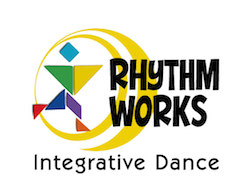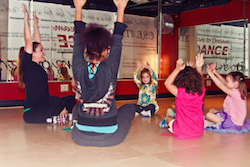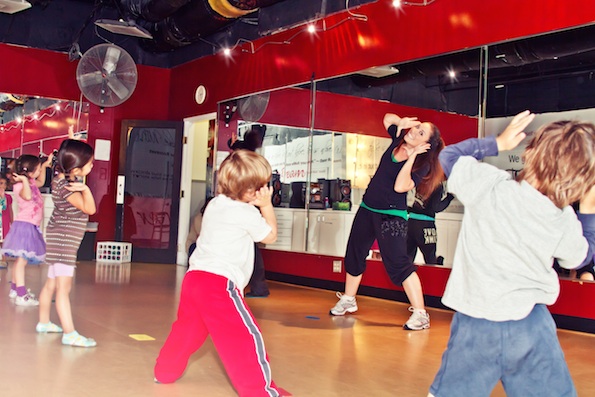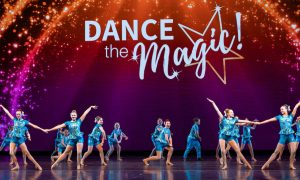By Laura Di Orio of Dance Informa.
As most dancers and dance educators know, dance can be a physical, mental and social outlet and can be a useful tool in a child’s development. Tricia Gomez, a teaching artist who has quite the extensive resume as a performer and educator, has created a new teaching system that will help bring dance and all of the art form’s positive effects to even more children, specifically those with learning challenges.
Using her own experiences as a teacher, while also working closely with an elite group of advisors over the past year, Gomez has introduced Rhythm Works Integrative Dance. This teaching tool is geared toward children ages three and up who suffer from autism, down syndrome, sensory integration disorders, ADHD and other developmental challenges.
Here, Dance Informa speaks with Gomez about how and why she devised this system and how interested teachers can become certified to be a Rhythm Works Integrative Dance provider and help make a difference in a child’s life.
Gomez started dancing at the young age of two but didn’t get serious about her training until she was in high school and fell in love with hip hop. She went on to dance professionally as a Los Angeles Laker Girl and with Disney, Universal Studios and Knott’s Berry Farm. She also choreographed for numerous professional NBA dance teams and for the show Saved By the Bell. In 2002, Gomez opened up her own dance studio in Los Angeles and has had an illustrious career as a dance teacher and dance judge, and she even became the dance expert for the Dr. Phil Show.
In 2006, she launched her youth hip hop program, Hip Hop in a Box/Hip Hop Made Easy, which is now offered in 2,000 dance studios and academic schools around the world. Her box kits include CDs, a DVD with sample routines and steps, flash cards with dance steps and tips on how to run a structured, yet fun, class.

Rhythm Works Integrative Dance is a teaching tool geared toward kids with learning challenges.
Throughout her years of training teachers at various dance teacher conferences, Gomez was often approached with questions about using Hip Hop in a Box with autistic kids.
“I started to see a need and knew from experience that Hip Hop in a Box worked wonderfully with my kids who had individual learning challenges because the steps were easy to relate to,” Gomez says. “But I wanted to develop a program that was purposeful and offered more than just a fun dance experience. This past year has been spent educating myself on the science of sensory integration and behavioral therapies, and I couldn’t be more excited about where this project is going!”
The result is Rhythm Works Integrative Dance, and with this system, Gomez hopes to bring hip hop dance to the masses in a format that is simple and able to be duplicated. Rhythm Works Integrative Dance uses Hip Hop in a Box as its core but is modified and customized to its audience.
“Rhythm Works Integrative Dance goes well beyond the art of dance,” she adds. “Emerging studies are starting to show that sound and rhythm have great effects on the brain. Over the next few years, we hope to be able to show that by adding purposeful movement to specific music and rhythms, new neuropathways are created to override under- or over-functioning pathways, which would aid in helping kids better organize their brains and self-regulate.”
Gomez will work closely with teachers to train them as Rhythm Works Integrative Dance Certified Educators.
“As dance teachers, we hold the key to connecting with kids through this modality,” she says. “The autistic population is not getting smaller. In fact, currently one in 68 kids are diagnosed with autism. This isn’t counting the undiagnosed kids who suffer with sensory integration problems. These kids want and need to be part of society in an inclusive setting, but many dance teachers, although well-intentioned, just don’t have the tools necessary to provide an atmosphere where the child will be successful, especially for more moderate to severely diagnosed kids. Rhythm Works Integrative Dance will close this gap by providing a pathway for a successful transition into inclusive classes.”
The ideal teacher will have at least three to five years of experience teaching dance and will have a desire to help children develop to their fullest potential. Gomez says a Rhythm Works Integrative Dance Certified Educator should also have a big heart, patience and the ability to connect with each child.

Rhythm Works Integrative Dance held its first teacher certification program in Los Angeles and will continue to train teachers and therapists around the world. Photo by Arthur Crenshaw.
While Rhythm Works Integrative Dance will be easy enough for a therapist with no dance experience to use, it is also suitable for dance teachers who have never before worked with a special needs population.
“Part of our certification training will educate the dance teachers on how to work with this population,” Gomez adds. “I do think it’s important, however, that our certified teachers have a minimum of three to five years of typical teaching experience so they are used to thinking quickly on their feet and have the confidence to lead a class that can, and will most likely, be extremely challenging at times. In addition to this initial training, the certification and licensing will include continuing education to keep our teachers on their toes!”
For now, Gomez says that Rhythm Works Integrative Dance only focuses on hip hop dance. She notes that hip hop is universally accepted among boys and girls and children’s parents. If an interest arises in other styles of dance such as ballet, tap or jazz, however, then Gomez may devise such a program.
Gomez has already completed her first group training of therapists and teachers in the Los Angeles area. Rhythm Works Integrative Dance certification will soon be offered in other locations around the United States, Canada and possibly Australia. Due to the vast amount of information and hands-on training that will be required, the certification will not be offered online. Once certified, teachers can offer Rhythm Works Integrative Dance in individual, small group and large group settings.
“I want to be clear that Rhythm Works Integrative Dance is not dance therapy,” Gomez explains. “Although we use it alongside existing therapies, it is a modality, a tool per se, used to help reach certain goals. In no way, shape or form are we claiming that this alone will be a cure or will work for every child.”
That said, however, Gomez strongly believes that Rhythm Works Integrative Dance has the potential to bring a sense of joy and acceptance to students.
“As teachers, there is nothing more satisfying than to watch our students develop to their fullest potential,” she says. “Knowing that you are a part of that provides a sense of purpose and knowledge that we are making a difference in the world.”
To learn more about Rhythm Works Integrative Dance or to get on the mailing list for upcoming trainings, contact Gomez at tricia@danceinabox.com, or visit danceinabox.com.
Photo (top): Tricia Gomez, creator of Rhythm Works Integrative Dance, leads a dance class. Photo by Arthur Crenshaw.















